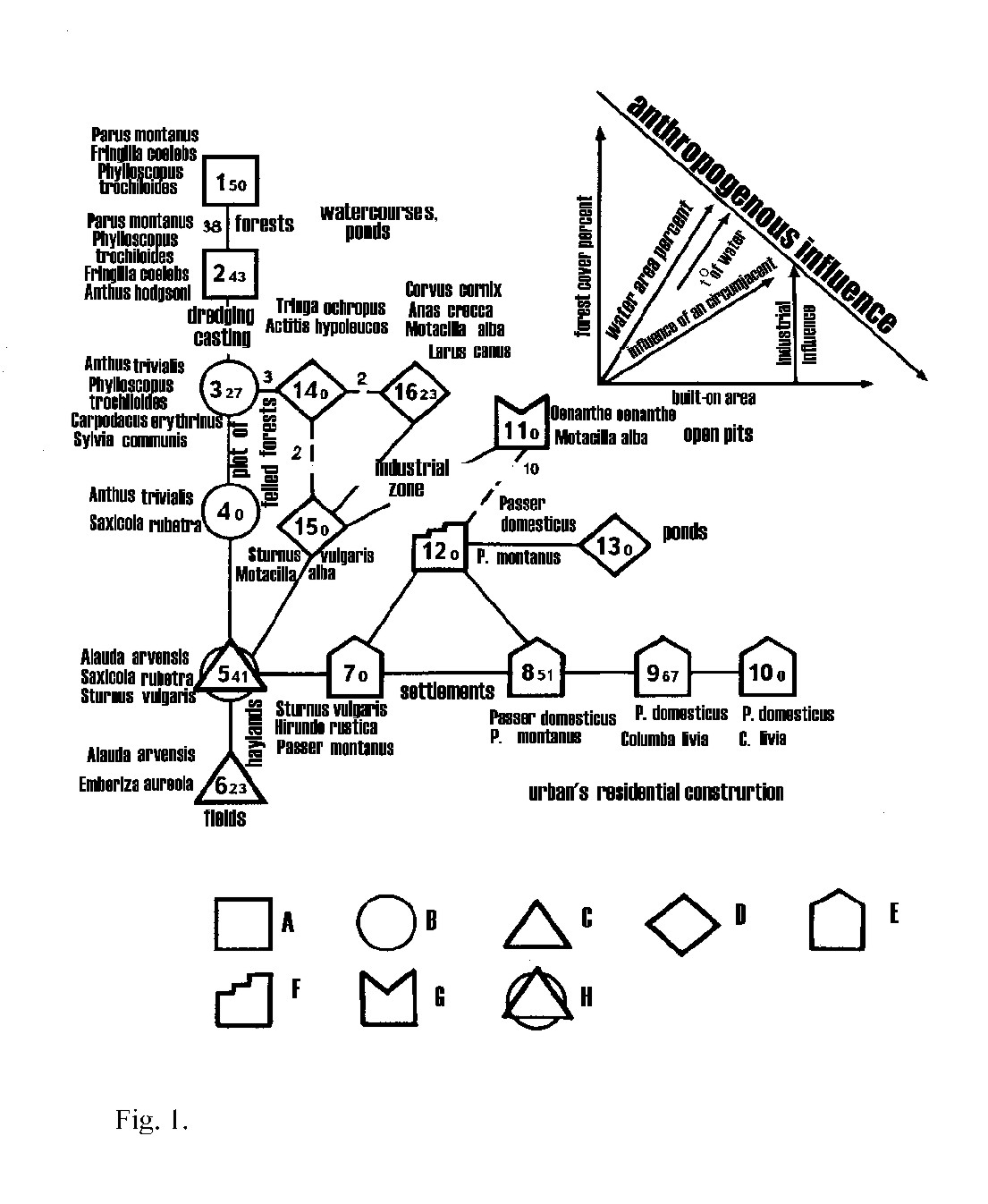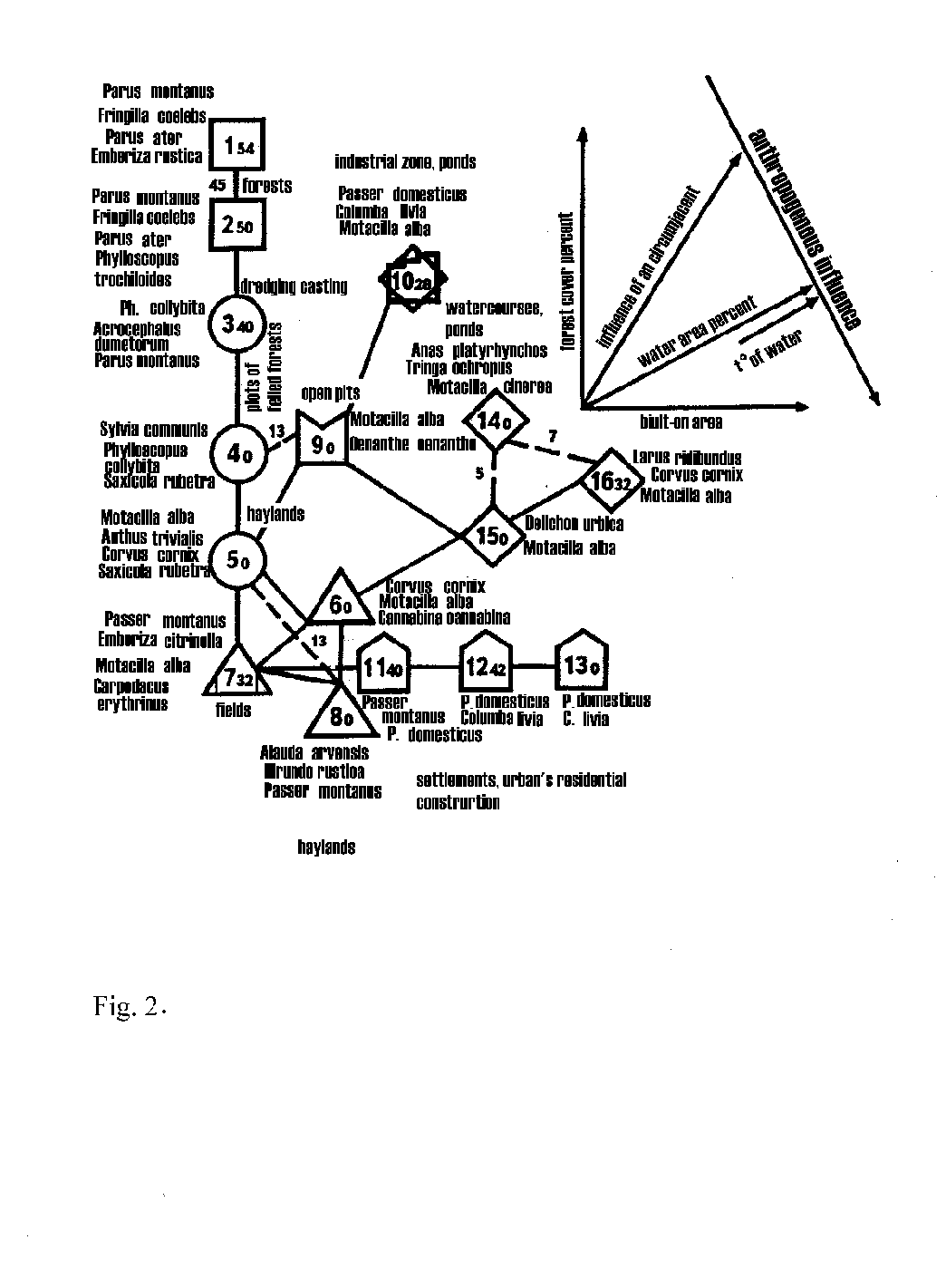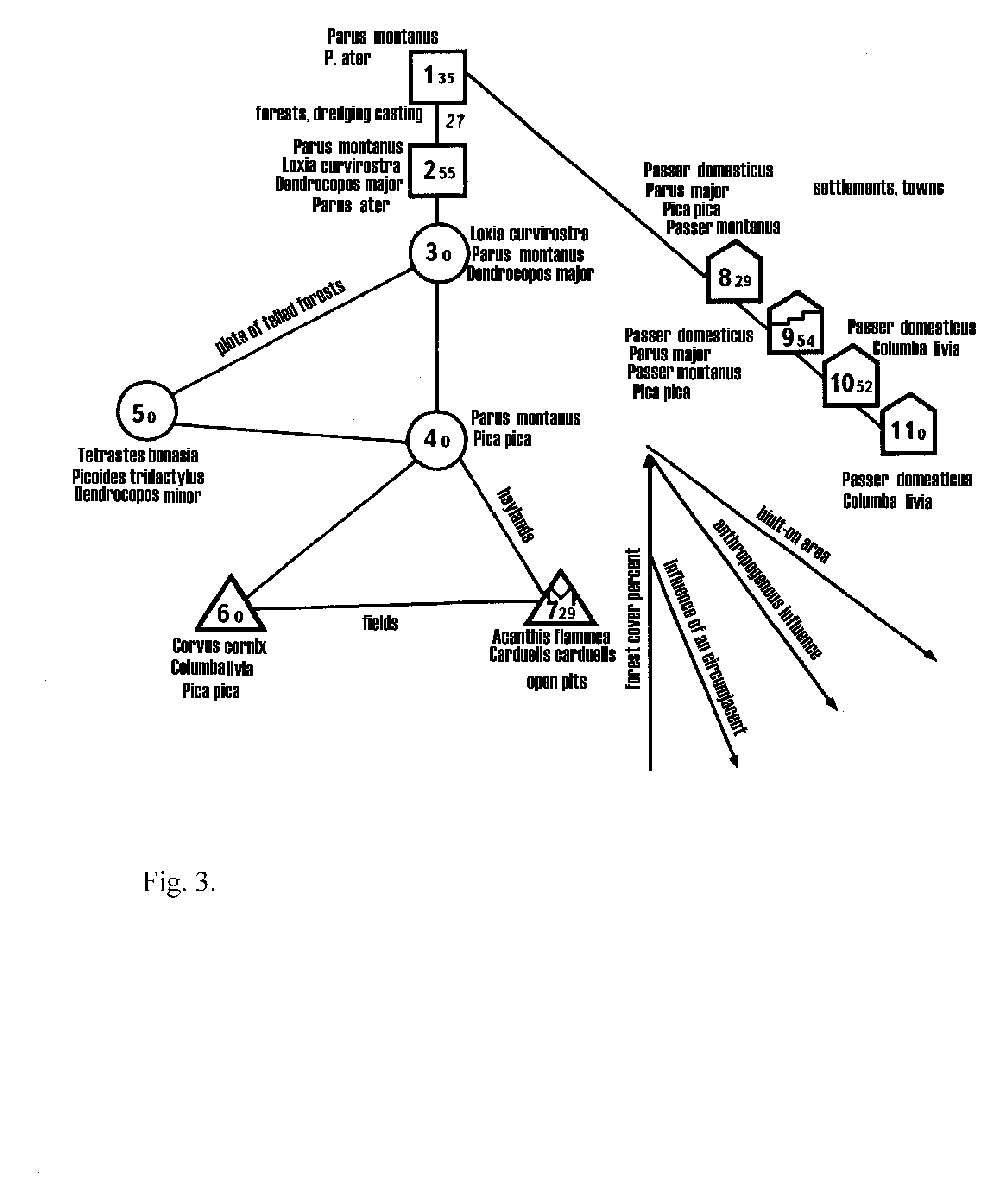SPATIAL HETEROGENEITY OF THE BIRD
COMMUNITIES VARIETY IN THE SOUTHERN TAIGA OF MIDDLE URALS
S.G.Livanov*
Laboratory
of zoological monitoring, Institute of Systematics
and Ecology of Animals, Siberian Branch of Russian Academy of Sciences,
Fax: (3832)
170973, E-mail: zm2@eco.nsc.ru
*To whom
correspondence should be addressed: IS&EA SB RAS,
Key words
Structure,
organization, bird communities, trends, gradients, Middle Urals
Summary
We carried out
multidimensional factor analysis of bird numbers data in 31 habitats of Middle
Urals (from primary fir-spruce forests to urban residential areas). Basing on
the results we constructed the graphs of spatial-typological bird community
structures for first and second halves of summer, and winter, and then we
performed the multiple estimation of the linkage closeness between variants and
environmental factors. The comparison of the graphs has shown, that in all
above seasons the spatial heterogeneity of the bird communities is generally
determined by the following environmental gradients: percentage of forest
cover, built-on area, influence of surrounding landscapes, and influence of
anthropogenous pressure in general. Additionally, in summer there were significant
influence of water area percentage, temperature of water in water basins, and,
particularly, industrial influence in its first half. In the first half of the
summer the combination of 27 environmental regimes approximated 90 % of
variance of bird community spatial heterogeneity; in the second half of summer
31 regimes approximated 89 % of variance; in winter 26 regimes accounted for 87
% of variance. The comparison of bird community spatial organization of Middle
Urals and neighboring geographic provinces has shown, that the differences
between them are conditioned, mainly, by geomorphological features and state of
economic development.
Introduction
Middle Urals geographical province
is situated mainly within the limits of western and southwestern Sverdlovsk
Region. Its mountain part is characterized by low-mountainous and depressed-plainly
relief, with the altitudes are less, than 800 m above see level. Originally,
more than 98 % of territory was woodlands. But current spatial heterogeneity of
territory is the result of different forms of anthropogenous influence. Bird
fauna of the province is well investigated, however, integral estimation of
bird community spatial heterogeneity and analysis of environmental factors
determining this heterogeneity for the whole province have not been carried out
at the moment.
Thus, the aim of the work is to reveal
the typological features of spatial bird community organization.
Materials and methods
The routing accounts of birds are carried out
in 1983-88, from May, 16th to August, 31st and from January, 16th to February,
28th. In summer the counts were performed fortnightly, the length of the route
in each habitat was 5 km. In winter we passed 10 km in every habitat. We
investigated 31 habitats (from primary fir-spruce forests to urban residential
areas). In total we registered 173 bird species and went 1539 km with basic
routing accounts. The analysis is carried out on average summer and initial
winter data of bird census for everyone habitat. The summer data were averaged
for two periods (from May, 16th up to July, 15th and July, 16th up to August,
31st).
The typological schemes of spatial structures
were constructed with the help of multidimensional factor analysis on matrixes
of similarity coefficients [Kupershtokh, Trofimov, 1975 a, b; Trofimov, 1978;
Trofimov etc., 1980; Ravkin, 1984]. For closeness measure of the bird
communities the Jacquard coefficient was used in modification for quantitative
attributes [Naumov, 1964]. The structures are represented as digraphs. The
graphs are oriented according to environment gradients, which are most
significant for spatial bird distribution. For finding - out of a significance
of each species in intraclass similarity we used the program developed by
Kupersptokh [see Ravkin, 1984]. The multiple correlation of variability of the
bird communities and environment factors is fulfilled with the help with factor
classification [Trofimov, 1976; Trofimov, Ravkin, 1980]. At revealing hierarchy
significant of factor combinations for birds the procedure of influence
demounting of stronger factors was applied. The value of compositions and its
combinations is appreciated the taken into account dispersion and expressed in
percentages.
Results
and discussion
The accepted graph's variant of first half of
summer illustrates mainly dependence of spatial heterogeneity of bird
communities from seven environment gradients (fig. 1).

Fig. 1. Spatial-temporal structure of the bird
communities in the southern taiga of the Middle Urals in first half of summer.
The description for a fig. 1.
The bird community classes of:
forests (A); when the open spaces alternate with forest sites (B); fields and
haymaking territories (C); water habitats (D); inhabited building areas (E); industrial
zones (F); open pits (G); the imposing of figures means, that the similar bird
communities variants are formed in different habitats (H).
The index of class number shows average
similarity of variants, included in this class (at one-element classes the
index is 0). The intraclass similarity of bird communities is illustrated by species-edificators
(they are given about classes). The trends of changes of bird community classes
and their caused environmental gradients are shown in additional coordinates. The
direction of a vector specifies increase of influence force of the
environmental factor. The graphs are made so the maximal interclass similarity
is shown by most short distance between classes and than this linkage is less
as far as distance is longer. The dashed lines indicate the linkages without
scale. In this case, the interclass similarities are shown too.
The graph demonstrates
that the bird community classes of different natural landscapes vary according
to increase percentage of forest cover in these habitats. In main, the
sequential likeness of classes (from first to sixth) is provided with changes
of abundances of ten species. It is Skylark (Alauda arvensis), Yellow-Breasted
Bunting (Emberiza aureola), Whinchat (Saxicola rubetra), Pied Wagtail (Motacilla
alba), Tree Pipit (Anthus trivialis), Chiffchaff (Phylloscopus collibyta), Green
Warbler (Ph. trochiloides), Chaffinch (Fringilla coelebs), Coal Tit (Parus ater)
and Willow Tit (P. montanus). In anthropogenous landscapes the bird community differences are
determined by a gradient of built-on area (fifth, seventh - tenth classes).
First of all, the similarity of bird community variants of this group is
defined by deal and abundance of nine species in the habitats. This is Skylark,
Whinchat, Starling (Sturnus vulgaris), Pied Wagtail,
Swallow (Hirundo rustica), House Martin (Delichon urbica), Tree Sparrow (Passer
montanus), House Sparrow (P. domesticus) and Rock Dove (Columba livia). The
trends of industrial and hydraulicity effect are more conditional (eleventh -
sixteenth). The low productiveness of
such communities causes an obvious incongruity between by typological likeness
of habitats and assemblages of their inhabitants. In poor habitats the
influence of circumadjacent landscape can be significant for formation of
appearance of bird communities. Sometimes, it is more potently, than
morphological features of habitats. However, in this period of summer influence
of surrounding landscape appears locally. It was obvious only for the most
derelict and poor communities (seventh, twelve and thirteenth classes). In the bird communities of industrial habitats
the changes demonstrate increasing differences from bird assemblages of
building zones, rather than sequential likeness with them (seventh, eighth,
twelve and eleventh classes). For two last trends reference species are absent.
The gradient of influence of water area percentage designates qualitative
differences of bird communities of aquatic habitats more, than orientation of
increasing differences inside this group (for example, from third to fourteenth
and from twelve to thirteen). The increase of influence of water area
percentage is demonstrated by fifth, fifteenth and sixteenth classes only. In
main this trend is caused by changes of abundances of ten species in
communities. It is Starling, Swallow, Pied Wagtail, Grey Wagtail
(Motacilla cinerea), Hooded Crow (Corvus cornix), Green Sandpiper (Tringa
ochropus), Common Sandpiper (Actitis hypoleucos), Tufted Duck (Aythya
fuligula), Black-Head Gull (Larus ridibundus) and Teal (Anas crecca). The resultant vector of the graph coincides with
an amplification of anthropogenous pressure. Thus in this period of time the
forms of economic activity have not a major significance, and more it is power
of habitat transformations.
In the second half of summer the
spatial-typological structure of bird communities is rather similar (fig. 2).

Fig. 2. Spatial-temporal structure of the bird
communities in the southern taiga of the Middle Urals in second half of summer
(the denotations as in a fig. 1).
The features consist in the following. The
influence of surrounding landscape amplifies. The trend of industrial effect
does not appear. It is caused by an amplification of a tolerance for many birds
to habitus of landscapes in periods of local moving and flyover. In the second
half summer there are significant both power
of habitat transformations, and forms
of human activity. The species composition of edificators of likeness
partially varies. Let's consider the trend of increase percentage of forest cover. The number of
species-edificators has increased up to eighteen. As edificator the Yellow-Breasted Bunting is not became
significant, but Swallow, Tree
Sparrow, Common Rosefinch (Carpodacus
erythrinus), Yellowhammer (Emberiza citrinella), Hooded Crow, Linnet (Acanthis
cannabina), Whitethroat (Sylvia communis), Blyth’s Reed Warbler (Acrocephalus
dumetorum) and Rustic Bunting (Emberiza rustica) were added. In main six
species determines changes of bird communities according to gradient of
built-on area (there were nine in first half of summer). It is Tree Sparrow, Yellowhammer, Pied Wagtail, Common Rosefinch, House Sparrow and Rock
Dove. The abundance changes of eight species-edificators characterize a trend
according to increase of water area percentage. There are Linnet, Hooded Crow, Pied Wagtail, House
Martin, Black-Head Gull, Mallard (Anas platyrhynchos), Green Sandpiper and Grey
Wagtail. The spatial abundance dynamics of fourteen species characterizes trend
of influence of surrounding landscapes. The Pied Wagtail, Tree Sparrow and
Hooded Crow are most significant among them.
The winter spatial heterogeneity of bird is
made by identical structuring environment factors, but character of vector
changes of bird communities is other (fig. 3).

Fig. 3. Spatial-temporal structure of the bird
communities in the southern taiga of the Middle Urals in winter (the
denotations as in a fig. 1).
Discontinuity of differences of bird communities
becomes sharply amplified between woodless habitats (fresh cutting areas,
fields, haymaking areas, open pits) and by forests and between above-mentioned
group and by settlements. The influence of
surrounding landscape is most significant for creation of bird communities in
open habitats. The graph, still, is oriented according to increase of
anthropogenous influence. In winter, this
trend is equispaced from woods both to open landscapes, and to urban
residential areas. It speaks that spatial dynamics of bird communities coincide
with a power of anthropogenous influence in summer and in winter the forms of
this impacts is significant more.
In the first half of the summer the combination
of 27 environmental regimes approximated 90 % of variance of bird community
spatial heterogeneity. The bird communities of woody habitats have the greatest
likeness. First of all their variability is stipulated by three regimes. The
closeness of variants, mainly, is determined by woody percentage in the
habitats. The significance of a composition of tree races and mosaic structure
appears only after removal of influence of more strong factors. Specificity of
a landscape's membership and wood's age appear after repeated removal only. The
affinity of bird communities of different fields and haymaking territories is
almost so high. In the main it is determined by one regime. The communities of
open pits sharply differ from a remaining sample and characterize by the
specific regime. The occurrence of building determines individual differences
of bird communities of these territories from other variants, but the likeness
and distinction inside this group is stipulated by the type of building. The
presence of a water surface in habitats determines difference of each of
near-water variants from dry bird communities only. A generality of near-water
group is low in itself.
In the second half of summer 31 regimes approximated 89 % of variance. In this period the significance of
forest clad and built-on areas are incremented, but, as such, the compositions
of wood breeds and the types of building are become small significant. The
influence of woody dynamics also weakens. At this time of year the likeness of
bird communities is reduced in the woodless habitats and territories without
buildings. The forms of human activity become more expressed for communities.
In the water habitats the generality of the bird's variants grows. It is
provided by moving and flyover of birds and by appearance of young birds. It is
governed by bird’s moving and flyover and by appearance of young birds.
In winter 26 regimes accounted for 87 % of
variance. As a whole, the aggregates of regimes are close to those for the
second half of summer. The main features consist in the following. In the
winter in built up territories the affinity of the bird communities is a small
higher, than by summer, and, mainly, their variability is defined by settlement
sizes, instead of types of buildings.
The comparisons of spatial heterogeneity of the
bird communities of Middle Urals are carried out with results of similar
investigations for Russian and West-Siberian Plains, mountains of the
Literature
Kupershtokh V.L., Trofimov
V.A. Automatic detection of a macrostructure of the system // The problems of the analysis of the discrete informations. -
Kupershtokh V.L., Trofimov
V.A Automatic detection of a macrostructure of the system // The role of animals
in operations of ecosystems. -
Naumov R.L. The birds in the centers of
Russian tick-borne encephalitis in the Krasnoyarsk Region. Synopsis
of thesis. -
Ravkin Yu.S.
Spatial organization of the bird communities in the forest zone (Western and
The spatio-temporal
dynamics of animal communities. -
Trofimov V.A Models and methods of the qualitative and factor analysis of a matrix of
link // The problems of the analysis of the discrete informations.
Part. 2. -
Trofimov V.A The qualitative factor analysis
of matrixes of links in space of splittings with
structure // The models of aggregation of the socio-economic informations. -
Trofimov V.A, Kupershtokh
V.L., Ravkin Yu.S. To a
problem of detection spatio-typological structures of
communities // The problems of zoogeography and history of Fauna. -
Trofimov V.A, Ravkin Yu.S. The express-method of the link estimation
of spatial heterogeneity of the animal communities and environment factors //
Quantitative methods in ecology of animal. -